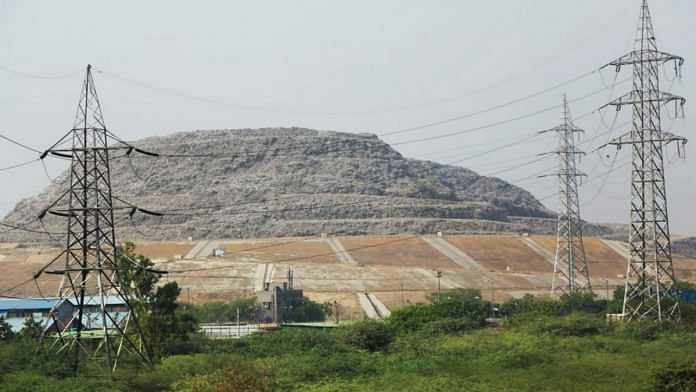New Delhi: Here’s a piece of bad news for the residents of East Delhi and the adjoining areas of Ghaziabad on World Environment Day — the record-breaking Ghazipur landfill is only set to become a bigger and bigger problem over the next few months and years.
At 65 metres tall, Ghazipur — Delhi’s biggest landfill — is almost as tall as the Taj Mahal. It holds 140 lakh metric tonnes of waste across 70 acres, and its potent stench travels far.
But between the lack of an efficient waste management system and a dearth of land for new dumps, the fate of the Ghazipur landfill is clear — the filth will continue to mount, and the surroundings will be further steeped in disease and pollution.
“For the foreseeable future, garbage will continue to be dumped there,” a chief engineer with the East Delhi Municipal Corporation told ThePrint. “There’s no other land for us to use, so there’s no option but to dump at Ghazipur. Nothing can be done about it yet.”
Plans come to nought
Ghazipur is one of three landfills in the city, with South Delhi’s 48-metre-high Okhla dump and North Delhi’s 40-metre-high Bhalaswa dump being the others. All three are steadily growing in size. They’re are located within the city, and their management and segregation is relegated to migrants or low-income residents who live among the filth.
“Waste comes in trucks all day and night — between 2,500 and 3,000 metric tonnes per day,” said Pramod Kumar, who is in charge of keeping track of incoming trucks and weighing the waste.
In 2016, some part of this waste was planned to be reused by the National Highway Authority of India (NHAI) to build the Delhi-Meerut expressway. Now, nearly 50 per cent of the project is complete, but the Ghazipur dump is only growing bigger.
“The NHAI initiative is the only option to substantially reuse the waste,” said the chief engineer. “We had signed a Memorandum of Understanding with the NHAI in 2016, but three years later, nothing has come of it.”
Also read: Environment is the most under-reported disaster of Narendra Modi government
Environmental hazard
Swati Singh Sambayal, programme manager at the Centre for Science and Environment, described the Ghazipur landfill as “a ticking time bomb”.
“It’s full of methane, leading to fires. Methane is also one of the potent greenhouse gases that leads to global warming.”
But the bigger problem, according to Sambyal, is Indians’ mindset towards waste.
“The municipal corporations are always looking for more land to dump garbage on to, and it will always be in a poor person’s backyard. That has to stop. We need a waste management system that will actually segregate this waste at its source, so we don’t create more landfills as disastrous as Ghazipur,” she said.
The only respite from the mounting garbage — which killed two people in 2017 when part of the dump collapsed — is the waste-to-energy plant set up next to the landfill. Even this, however, reuses only a fraction of the dump’s resources.
“About 1,500 metric tonnes of the incoming waste goes to the plant per day. But only combustible waste is used, so the 700 metric tonnes which can’t be used goes back to the landfill,” said the chief engineer.
“Even though the energy plant creates electricity, we don’t get any of it,” said Jayprakash Tiwari, a shopkeeper in Ghazipur village.
“During election time, many visits were made here by the MCD men. They disinfected the water by putting mosquito repellent in it. But they hardly came before that.”
Contaminated land and groundwater
The land upon which Ghazipur sits is deeply contaminated. A thick, black poisonous stream of water pours out from under it and runs along the gutter that lines the dumpyard. The total dissolved solids in this water range between 2,825 ppm (parts per million) to 3,300 ppm — far above the 3-5ppm range for potable water.
The government’s way of compensating for this is to send free water from the Delhi Jal Board to the residents of the area every few days. “But we only use that water for drinking and cooking. It isn’t enough for all our needs. We still use the pump water to bathe and wash our clothes. It is yellow and stinky,” said Paramvir Singh, who owns a barber shop behind the dump.
Waste needs to become the generator’s responsibility
Delhi’s growing boundaries since Ghazipur was set up in 1982 have also led to the waste crisis the city now faces.
“As boundaries are further stretched, management systems become more difficult to reach. Waste also becomes pushed out of sight, and so, is considered out of mind,” Sambayal said.
“End-to-end segregation, where waste becomes the generator’s responsibility, is the only way to ensure a sustainable future.”
Till then, it is the problem of Ghazipur’s residents, some of whom work in the dump, and all of whom must deal with its consequences.
Also read: On World Environment Day, a look at the global green problems killing Mother Nature




Just type in Google, find out which city is doing best in waste management, go there, learn and implement it, analyse/improve the system. Gentlemen, with your salary, perks, authority and resources…do you think common people like us should teach you what you are supposed to do? Shame!
Population control needs to be implemented asap
We need to find environment-friendly, efficient ways to dispose garbage and waste, in addition to generating less of it. Just because you’ve left garbage outside your house doesn’t mean your home is safe. If current ways of getting rid of it continue, we’ll bear, perhaps already are, the consequences of this dysfunctional way that is permeating our consumption cycle, including our food, water and air–all contributing to increasing impurities and diseases